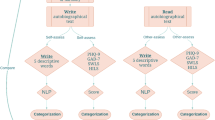Abstract
This work applies Natural Language Processing (NLP) techniques, specifically transformer models, for the emotional evaluation of open-ended responses. Today’s powerful advances in transformer architecture, such as ChatGPT, make it possible to capture complex emotional patterns in language. The proposed transformer-based system identifies the emotional features of various texts. The research employs an innovative approach, using prompt engineering and existing context, to enhance the emotional expressiveness of the model. It also investigates spaCy’s capabilities for linguistic analysis and the synergy between transformer models and this technology. The results show a significant improvement in emotional detection compared to traditional methods and tools, highlighting the potential of transformer models in this domain. The method can be implemented in various areas, such as emotional research or mental health monitoring, creating a much richer and complete user profile.
Access this chapter
Tax calculation will be finalised at checkout
Purchases are for personal use only
Similar content being viewed by others
Notes
- 1.
Available at https://openai.com, reviewed in January 2024.
- 2.
Available at https://ai.google, reviewed in January 2024.
- 3.
Available at https://www.anthropic.com/, reviewed in January 2024.
- 4.
Available at https://www.anthropic.com/index/introducing-claude, reviewed in January 2024.
- 5.
Available at https://inflection.ai/about, reviewed in January 2024.
- 6.
Available at https://lmsys.org/blog/2023-03-30-vicuna/, reviewed in January 2024.
- 7.
A conversation comprises one or more interspersed interactions between speakers.
- 8.
Available at https://www.json.org/json-en.html, reviewed in January 2024.
- 9.
Word used to designate a set of input characters submitted to the model.
- 10.
Available at https://spacy.io, reviewed in January 2024.
- 11.
Available at https://spacy.io/universe/project/spacy-textblob reviewed in January 2024.
- 12.
Available at https://textblob.readthedocs.io/en/dev/, reviewed in January 2024.
- 13.
Available at https://www.kaggle.com/datasets/projjal1/human-conversation-training-data, reviewed in January 2024.
- 14.
Available at https://www.kaggle.com/datasets/miguelcorraljr/ted-ultimate-dataset, reviewed in January 2024.
- 15.
Available at https://huggingface.co/datasets/hita/social-behavior-emotions, reviewed in January 2024.
- 16.
The model hyperparameters were set to temperature=0.0, \({\small {\texttt {top}}}\_{\small {\texttt {p=1.0}}}\) (default value), \(\small {\texttt {frequency}}\_\small {\texttt {penalty=0.0}}\) (default value), \(\small {\texttt {presence}}\_\small {\texttt {penalty=0.0}}\) (default value) and \(\small {\texttt {stop}}\_\small {\texttt {sequence=None}}\) (default value).
References
Al-Omari, H., Abdullah, M.A., Shaikh, S.: EmoDet2: emotion detection in English textual dialogue using BERT and BILSTM models. In: 2020 11th International Conference on Information and Communication Systems (ICICS), pp. 226–232. IEEE (2020)
Brown, T., et al.: Language models are few-shot learners. In: Advances in Neural Information Processing Systems. vol. 33, pp. 1877–1901. Curran Associates, Inc. (2020)
Dale, R.: GPT-3: what’s it good for? Nat. Lang. Eng. 27(1), 113–118 (2021)
Hartmann, J., Netzer, O.: Natural language processing in marketing. In: Artificial Intelligence in Marketing, vol. 20, pp. 191–215. Emerald Publishing Limited (2023)
Kai, W., Lingyu, Z.: Research on text summary generation based on bidirectional encoder representation from transformers. In: 2020 2nd International Conference on Information Technology and Computer Application (ITCA), pp. 317–321 (2020)
Khurana, D., Koli, A., Khatter, K., Singh, S.: Natural language processing: state of the art, current trends and challenges. Multimedia Tools Appl. 82(3), 3713–3744 (2023)
Liu, Y., et al.: A survey of visual transformers. IEEE Trans. Neural Netw. Learn. Syst., 1–21 (2023)
Mann, P., Matsushima, E.H., Paes, A.: Detecting depression from social media data as a multiple-instance learning task. In: 2022 10th International Conference on Affective Computing and Intelligent Interaction (ACII), pp. 1–8 (2022)
Mao, R., Liu, Q., He, K., Li, W., Cambria, E.: The biases of pre-trained language models: an empirical study on prompt-based sentiment analysis and emotion detection. IEEE Trans. Affect. Comput. 14(3), 1743–1753 (2023)
Masuda, K., Matsuzaki, T., Tsujii, J.: Semantic search based on the online integration of NLP techniques. Procedia Soc. Behav. Sci. 27, 281–290 (2011). Computational Linguistics and Related Fields
Peng, S.: A survey on deep learning for textual emotion analysis in social networks. Digit. Commun. Netw. 8(5), 745–762 (2022)
Shen, J.T., et al.: MathBERT: a pre-trained language model for general NLP tasks in mathematics education (2023)
Sun, Z., Wang, M., Li, L.: Multilingual Translation via Grafting Pre-trained Language Models (2021)
Taboada, M., Brooke, J., Tofiloski, M., Voll, K., Stede, M.: Lexicon-based methods for sentiment analysis. Comput. Linguist. 37(2), 267–307 (2011)
Touvron, H., et al.: LLaMA: open and efficient foundation language models (2023)
Tracy, J.L., Randles, D.: Four models of basic emotions: a review of Ekman and Cordaro, Izard, Levenson, and Panksepp and Watt. Emot. Rev. 3(4), 397–405 (2011)
Wang, C., Chen, Y., Zhang, S., Zhang, Q.: Stock market index prediction using deep transformer model. Expert Syst. Appl. 208, 118128 (2022)
Wehrmann, J., Becker, W., Cagnini, H.E.L., Barros, R.C.: A character-based convolutional neural network for language-agnostic twitter sentiment analysis. In: 2017 International Joint Conference on Neural Networks (IJCNN), pp. 2384–2391 (2017)
Wongkar, M., Angdresey, A.: Sentiment analysis using Naive Bayes algorithm of the data crawler: Twitter. In: 2019 Fourth International Conference on Informatics and Computing (ICIC), pp. 1–5 (2019)
Zainuddin, N., Selamat, A.: Sentiment analysis using Support Vector Machine. In: 2014 International Conference on Computer, Communications, and Control Technology (I4CT), pp. 333–337 (2014)
Zhou, Y., Kang, X., Ren, F.: Prompt consistency for multi-label textual emotion detection. IEEE Trans. Affect. Comput. 15, 1–10 (2023)
Acknowledgement
This work was partially supported by: (i) Xunta de Galicia grants ED481B-2021-118 and ED481B-2022-093, Spain; and (ii) Portuguese national funds through FCT – Fundação para a Ciência e a Tecnologia (Portuguese Foundation for Science and Technology) – as part of project UIDB/50014/2020 (DOI: 10.54499/UIDP/50014/2020 | https://doi.org/10.54499/UIDP/50014/2020).
Author information
Authors and Affiliations
Corresponding author
Editor information
Editors and Affiliations
Rights and permissions
Copyright information
© 2024 The Author(s), under exclusive license to Springer Nature Switzerland AG
About this paper
Cite this paper
Pajón-Sanmartín, A., de Arriba-Pérez, F., García-Méndez, S., Burguillo, J.C., Leal, F., Malheiro, B. (2024). Emotional Evaluation of Open-Ended Responses with Transformer Models. In: Rocha, Á., Adeli, H., Dzemyda, G., Moreira, F., Poniszewska-Marańda, A. (eds) Good Practices and New Perspectives in Information Systems and Technologies. WorldCIST 2024. Lecture Notes in Networks and Systems, vol 985. Springer, Cham. https://doi.org/10.1007/978-3-031-60215-3_3
Download citation
DOI: https://doi.org/10.1007/978-3-031-60215-3_3
Published:
Publisher Name: Springer, Cham
Print ISBN: 978-3-031-60214-6
Online ISBN: 978-3-031-60215-3
eBook Packages: Intelligent Technologies and RoboticsIntelligent Technologies and Robotics (R0)




